Energy Management for an Air Conditioning System Using a Storage Device to Reduce the On-Peak Power Consumption
Abstract
:1. Introduction
2. Materials and Methods
2.1. Concept of TES in Conjunction with an Air Conditioning System
2.2. Simulation of the Chilled Water Tank
2.3. Relations and Specific Boundaries of the Simulation
2.4. Economic Analysis
3. Results and Discussion
3.1. Temperature Changes in Storage Tanks during Discharging and Charging Stages
3.2. Operation Cycle of the Air Conditioning System with the TES Tank (H:D = 2)
3.2.1. When Chilled Water Was 5 °C from the Chiller
3.2.2. When the Chilled Water Was 4 °C from the Chiller
3.3. Economic Analysis
4. Conclusions
Author Contributions
Funding
Data Availability Statement
Acknowledgments
Conflicts of Interest
References
- Madurai Elavarasan, R.; Pugazhendhi, R.; Irfan, M.; Mihet-Popa, L.; Khan, I.; Campana, P. State-of-the-art sustainable approaches for deeper decarbonization in Europe—An endowment to climate neutral vision. Renew. Sustain. Energy Rev. 2022, 159, 112204. [Google Scholar] [CrossRef]
- Madurai Elavarasan, R.; Mudgal, V.; Selvamanohar, L.; Wang, K.; Huang, G.; Shafiullah, G.; Markides, C.; Reddy, S.; Nadarajah, M. Pathways toward high-efficiency solar photovoltaic thermal management for electrical, thermal and combined generation applications: A critical review. Energy Convers. Manag. 2022, 255, 115278. [Google Scholar] [CrossRef]
- Irfan, M.; Elavarasan, R.M.; Hao, Y.; Feng, M.; Sailan, D. An assessment of consumers’ willingness to utilize solar energy in China: End-users’ perspective. J. Clean. Prod. 2021, 292, 126008. [Google Scholar] [CrossRef]
- Nuvvula, R.S.S.; Devaraj, E.; Elavarasan, R.M.; Taheri, S.I.; Irfan, M.; Teegala, K.S. Multi-objective mutation-enabled adaptive local attractor quantum behaved particle swarm optimisation based optimal sizing of hybrid renewable energy system for smart cities in India. Sustain. Energy Technol. Assess. 2022, 49, 101689. [Google Scholar] [CrossRef]
- Miyahara, A.A.L.; Paixão, C.P.; Santos, D.R.d.; Pagin-Cláudio, F.; da Silva, G.J.; Bertoleti, I.A.F.; de Lima, J.S.; da Silva, J.L.; Candido, L.F.; Siqueira, M.C.; et al. Urban dendrochronology toolkit for evidence-based decision-making on climate risk, cultural heritage, environmental pollution, and tree management—A systematic review. Environ. Sci. Policy 2022, 137, 152–163. [Google Scholar] [CrossRef]
- Jaeseok, C.; Kwang, Y.L. Best Generation Mix Considering Air Pollution Constraints. In Probabilistic Power System Expansion Planning with Renewable Energy Resources and Energy Storage Systems; IEEE: Manhattan, NY, USA, 2022; pp. 111–126. [Google Scholar]
- Elavarasan, R.M. The motivation for renewable energy and its comparison with other energy sources: A review. Eur. J. Sustain. Dev. Res. 2019, 3, em0076. [Google Scholar] [CrossRef] [PubMed] [Green Version]
- Gangatharan, S.; Rengasamy, M.; Elavarasan, R.M.; Das, N.; Hossain, E.; Sundaram, V.M. A Novel Battery Supported Energy Management System for the Effective Handling of Feeble Power in Hybrid Microgrid Environment. IEEE Access 2020, 8, 217391–217415. [Google Scholar] [CrossRef]
- Mulopo, J. A mini-review of practical interventions of renewable energy for climate change in Sub-Saharan Africa in the last decade (2010–2020): Implications and perspectives. Heliyon 2022, 8, e11296. [Google Scholar] [CrossRef] [PubMed]
- Shafiullah, G.; Masola, T.; Samu, R.; Elavarasan, R.M.; Begum, S.; Subramaniam, U.; Romlie, M.F.; Chowdhury, M.; Arif, M.T. Prospects of hybrid renewable energy-based power system: A case study, post analysis of Chipendeke Micro-Hydro, Zimbabwe. IEEE Access 2021, 9, 73433–73452. [Google Scholar] [CrossRef]
- Martinot, E.; Chaurey, A.; Lew, D.; Moreira, J.R.; Wamukonya, N. Renewable energy markets in developing countries. Annu. Rev. Energy Environ. 2002, 27, 309–348. [Google Scholar] [CrossRef]
- Elavarasan, R.M.; Pugazhendhi, R.; Jamal, T.; Dyduch, J.; Arif, M.T.; Kumar, N.M.; Shafiullah, G.; Chopra, S.S.; Nadarajah, M. Envisioning the UN Sustainable Development Goals (SDGs) through the lens of energy sustainability (SDG 7) in the post-COVID-19 world. Appl. Energy 2021, 292, 116665. [Google Scholar] [CrossRef]
- Sarita, K.; Kumar, S.; Vardhan, A.S.S.; Elavarasan, R.M.; Saket, R.; Shafiullah, G.; Hossain, E. Power enhancement with grid stabilization of renewable energy-based generation system using UPQC-FLC-EVA technique. IEEE Access 2020, 8, 207443–207464. [Google Scholar] [CrossRef]
- Electricity Generating Authority of Thailand. Peak Demand. 2016. Available online: https://www.egat.co.th/en/news-announcement/news-406release/peakdemand-forecast-to-occur-during-march-may-2016-due-to-the-hot-weather (accessed on 9 November 2019).
- Parkpoom, S.; Harrison, G.P. Analyzing the Impact of Climate Change on Future Electricity Demand in Thailand. IEEE Trans. Power Syst. 2008, 23, 1441–1448. [Google Scholar] [CrossRef] [Green Version]
- Turner, J.H. Theoretical Sociology: A Concise Introduction to Twelve Sociological Theories; SAGE Publications: London, UK, 2014. [Google Scholar]
- Rehman, A.U.; Wadud, Z.; Elavarasan, R.M.; Hafeez, G.; Khan, I.; Shafiq, Z.; Alhelou, H.H. An Optimal Power Usage Scheduling in Smart Grid Integrated with Renewable Energy Sources for Energy Management. IEEE Access 2021, 9, 84619–84638. [Google Scholar] [CrossRef]
- Saffari, M.; de Gracia, A.; Fernández, C.; Belusko, M.; Boer, D.; Cabeza, L.F. Optimized demand side management (DSM) of peak electricity demand by coupling low temperature thermal energy storage (TES) and solar PV. Appl. Energy 2018, 211, 604–616. [Google Scholar] [CrossRef] [Green Version]
- Elavarasan, R.M.; Shafiullah, G.M.; Padmanaban, S.; Kumar, N.M.; Annam, A.; Vetrichelvan, A.M.; Mihet-Popa, L.; Holm-Nielsen, J.B. A Comprehensive Review on Renewable Energy Development, Challenges, and Policies of Leading Indian States with an International Perspective. IEEE Access 2020, 8, 74432–74457. [Google Scholar] [CrossRef]
- Kumar, N.M.; Chopra, S.S.; Chand, A.A.; Elavarasan, R.M.; Shafiullah, G.M. Hybrid Renewable Energy Microgrid for a Residential Community: A Techno-Economic and Environmental Perspective in the Context of the SDG7. Sustainability 2020, 12, 3944. [Google Scholar] [CrossRef]
- Elavarasan, R.M.; Singh, P.; Leoponraj, S.; Khanna, S.; Chandran, M. Solar Photovoltaics Integrated With Hydrated Salt-Based Phase Change Material. J. Sol. Energy Eng. 2022, 144, 051004. [Google Scholar] [CrossRef]
- Velmurugan, K.; Elavarasan, R.M.; De, P.V.; Karthikeyan, V.; Korukonda, T.B.; Dhanraj, J.A.; Emsaeng, K.; Chowdhury, M.S.; Techato, K.; el Khier, B.S.A.; et al. A Review of Heat Batteries Based PV Module Cooling—Case Studies on Performance Enhancement of Large-Scale Solar PV System. Sustainability 2022, 14, 1963. [Google Scholar] [CrossRef]
- Singh, P.; Elavarasan, R.M.; Kumar, N.M.; Khanna, S.; Becerra, V.; Newar, S.; Sharma, V.; Radulovic, J.; Khusainov, R.; Hutchinson, D. Photovoltaic Thermal Collectors with Phase Change Material for Southeast of England; Springer: Berlin/Heidelberg, Germany, 2020; pp. 1425–1430. [Google Scholar]
- Kubaha, K. A Feasibility Study on the Use of Cool Storage for Air-Conditioning in a Hotel. Master’s Thesis, King Mongkut’s University of Technology Thonburi, Bangkok, Thailand, 1989. [Google Scholar]
- Boonnasa, S.; Namprakai, P. The chilled water storage analysis for a university building cooling system. Appl. Therm. Eng. 2010, 30, 1396–1408. [Google Scholar] [CrossRef]
- Zhang, Z.; Turner, W.D.; Chen, Q.; Xu, C.; Deng, S. Tank size and operating strategy optimization of a stratified chilled water storage system. Appl. Therm. Eng. 2011, 31, 2656–2664. [Google Scholar] [CrossRef]
- Lin, H.; Li, X.H.; Cheng, P.S.; Xu, B.G. A New Air-Conditioning System with Chilled Water Storage. Appl. Mech. Mater. 2013, 405–408, 2964–2968. [Google Scholar]
- T, S. Design and Development of Ice Thermal Energy Storage System for Air Conditioning in a Greenhouse. Master’s Thesis, Chiang Mai University, Chiang Mai, Thailand, 2014. [Google Scholar]
- Yan, C.; Shi, W.; Li, X.; Zhao, Y. Optimal design and application of a compound cold storage system combining seasonal ice storage and chilled water storage. Appl. Energy 2016, 171, 1–11. [Google Scholar] [CrossRef]
- Al Quabeh, H.; Saab, R.; Ali, M.I.H. Chilled Water Storage Feasibility with District Cooling Chiller in Tropical Environment. J. Sustain. Dev. Energy Water Environ. Syst. 2020, 8, 132–144. [Google Scholar] [CrossRef]
- Soler, M.S.; Sabaté, C.C.; Santiago, V.B.; Jabbari, F. Optimizing performance of a bank of chillers with thermal energy storage. Appl. Energy 2016, 172, 275–285. [Google Scholar] [CrossRef]
- Comodi, G.; Carducci, F.; Nagarajan, B.; Romagnoli, A. Application of cold thermal energy storage (CTES) for building demand management in hot climates. Appl. Therm. Eng. 2016, 103, 1186–1195. [Google Scholar] [CrossRef]
- Sanaye, S.; Hekmatian, M. Ice thermal energy storage (ITES) for air-conditioning application in full and partial load operating modes. Int. J. Refrig. 2016, 66, 181–197. [Google Scholar] [CrossRef] [Green Version]
- Luo, N.; Hong, T.; Li, H.; Jia, R.; Weng, W. Data analytics and optimization of an ice-based energy storage system for commercial buildings. Appl. Energy 2017, 204, 459–475. [Google Scholar] [CrossRef] [Green Version]
- Said, M.A.; Hassan, H.H. A study on the thermal energy storage of different phase change materials incorporated with the condenser of air-conditioning unit and their effect on the unit performance. Energy Build. 2019, 202, 109353. [Google Scholar] [CrossRef]
- Narayanasamy, R.; Vellaichamy, P.; Ram, M.; Ramalingam, V. Experimental investigation on packed bed cool storage system for supply-demand management in building air-conditioning system suitable for micro thermal grid. Therm. Sci. 2019, 265. [Google Scholar] [CrossRef] [Green Version]
- Nie, B.; She, X.; Zou, B.; Li, Y.; Li, Y.; Ding, Y. Discharging performance enhancement of a phase change material based thermal energy storage device for transport air-conditioning applications. Appl. Therm. Eng. 2020, 165, 114582. [Google Scholar] [CrossRef]
- Nie, B.; Du, Z.; Zou, B.; Li, Y.; Ding, Y. Performance enhancement of a phase-change-material based thermal energy storage device for air-conditioning applications. Energy Build. 2020, 214, 109895. [Google Scholar] [CrossRef]
- Nelson, J.E.B.; Balakrishnan, A.R.; Murthy, S.S. Experiments on stratified chilled-water tanks: Expériences menées avec des reservoirs d’accumulation d’eau glacée à stratification. Int. J. Refrig. 1999, 22, 216–234. [Google Scholar] [CrossRef]
- Osman, K.; al Khaireed, S.M.N.; Ariffin, M.K.; Senawi, M.Y. Dynamic modeling of stratification for chilled water storage tank. Energy Convers. Manag. 2008, 49, 3270–3273. [Google Scholar] [CrossRef]
- Jabbar, A.; Khalifa, N.; Mustafa, A.T.; Khammas, F.A. Experimental Study of Temperature Stratification in a Thermal Storage Tank in the Static Mode for Different Aspect Ratios. J. Eng. Appl. Sci. 2011, 6, 53–60. [Google Scholar]
- Yaïci, W.; Ghorab, M.; Entchev, E.; Hayden, S. Three-dimensional unsteady CFD simulations of a thermal storage tank performance for optimum design. Appl. Therm. Eng. 2013, 60, 152–163. [Google Scholar] [CrossRef]
- Milaré, M.M.; Rocha, M.d.S.; Simões-Moreira, J.R. Hydrodynamic considerations on the performance of chilled water thermal storage tanks in the discharge cycle. J. Braz. Soc. Mech. Sci. Eng. 2015, 37, 285–296. [Google Scholar] [CrossRef]
- Ramesh, V.; Vishwakarma, S.; Roy, A.; Shendage, D. Analytical and experimental analysis of thermo-cline thermal energy storage tank. Int. Eng. Res. J. 2016, 1058–1068, ISSN: 2395-1621. [Google Scholar]
- Guo, X.; Goumba, A. Process Intensification Principles Applied to Thermal Energy Storage Systems—A Brief Review. Front. Energy Res. 2018, 6, 17. [Google Scholar] [CrossRef] [Green Version]
- Kurşun, B.; Ökten, K. Effect of rectangular hot water tank position and aspect ratio on thermal stratification enhancement. Renew. Energy 2018, 116, 639–646. [Google Scholar] [CrossRef]
- Karim, A.; Burnett, A.; Fawzia, S. Investigation of Stratified Thermal Storage Tank Performance for Heating and Cooling Applications. Energies 2018, 11, 1049. [Google Scholar] [CrossRef] [Green Version]
- Homan, K.O.; Soo, S.L. Laminar flow efficiency of stratified chilled-water storage tanks. Int. J. Heat Fluid Flow 1998, 19, 69–78. [Google Scholar] [CrossRef]
- Bahnfleth, W.P.; Song, J. Constant flow rate charging characteristics of a full-scale stratified chilled water storage tank with double-ring slotted pipe diffusers. Appl. Therm. Eng. 2005, 25, 3067–3082. [Google Scholar] [CrossRef]
- Chung, J.D.; Cho, S.H.; Tae, C.S.; Yoo, H. The effect of diffuser configuration on thermal stratification in a rectangular storage tank. Renew. Energy 2008, 33, 2236–2245. [Google Scholar] [CrossRef]
- Castell, A.; Medrano, M.; Solé, C.; Cabeza, L.F. Dimensionless numbers used to characterize stratification in water tanks for discharging at low flow rates. Renew. Energy 2010, 35, 2192–2199. [Google Scholar] [CrossRef]
- Karim, M.A. Experimental investigation of a stratified chilled-water thermal storage system. Appl. Therm. Eng. 2011, 31, 1853–1860. [Google Scholar] [CrossRef]
- Mira-Hernández, C.; Flueckiger, S.M.; Garimella, S.V. Numerical Simulation of Single- and Dual-media Thermocline Tanks for Energy Storage in Concentrating Solar Power Plants. Energy Procedia 2014, 49, 916–926. [Google Scholar] [CrossRef] [Green Version]
- Abdelhak, O.; Mhiri, H.; Bournot, P. CFD analysis of thermal stratification in domestic hot water storage tank during dynamic mode. Build. Simul. 2015, 8, 421–429. [Google Scholar] [CrossRef]
- Yang, Z.; Chen, H.; Wang, L.; Sheng, Y.; Wang, Y. Comparative study of the influences of different water tank shapes on thermal energy storage capacity and thermal stratification. Renew. Energy 2016, 85, 31–44. [Google Scholar] [CrossRef]
- Moncho-Esteve, I.J.; Gasque, M.; González-Altozano, P.; Palau-Salvador, G. Simple inlet devices and their influence on thermal stratification in a hot water storage tank. Energy Build. 2017, 150, 625–638. [Google Scholar] [CrossRef]
- Fang, Y.; Niu, J.; Deng, S. Optimizing LHS system using PCM in a tube-in-tank design for emergency cooling. Energy Procedia 2017, 142, 3381–3387. [Google Scholar] [CrossRef]
- Song, X.; Zhu, T.; Liu, L.; Cao, Z. Study on optimal ice storage capacity of ice thermal storage system and its influence factors. Energy Convers. Manag. 2018, 164, 288–300. [Google Scholar] [CrossRef]
- Fang, Y.; Niu, J.; Deng, S. Numerical analysis for maximizing effective energy storage capacity of thermal energy storage systems by enhancing heat transfer in PCM. Energy Build. 2018, 160, 10–18. [Google Scholar] [CrossRef]
- Sun, Q.; Wang, H.; Dong, K.; Lv, T.; Kang, Z. Experimental study on the thermal performance of a novel physically separated chilled water storage tank. J. Energy Storage 2021, 40, 102628. [Google Scholar] [CrossRef]
- Sebzali, M.J.; Ameer, B.; Hussain, H.J. Comparison of energy performance and economics of chilled water thermal storage and conventional air-conditioning systems. Energy Build. 2014, 69, 237–250. [Google Scholar] [CrossRef]
- Majid, M.A.A.; Hui, P.S.; Soomro, A.A. Performance assessment of stratified chilled water thermal energy storage tank at district cooling plant. IOP Conf. Ser. Mater. Sci. Eng. 2020, 863, 012032. [Google Scholar] [CrossRef]
- Shakerin, M.; Eikeskog, V.; Li, Y.; Harsem, T.T.; Nord, N.; Li, H. Investigation of Combined Heating and Cooling Systems with Short- and Long-Term Storages. Sustainability 2022, 14, 5709. [Google Scholar] [CrossRef]
- Shin, D.U.; Ryu, S.R.; Kim, K.W. Simultaneous heating and cooling system with thermal storage tanks considering energy efficiency and operation method of the system. Energy Build. 2019, 205, 109518. [Google Scholar] [CrossRef]
- Kurşun, B. Thermal stratification enhancement in cylindrical and rectangular hot water tanks with truncated cone and pyramid shaped insulation geometry. Sol. Energy 2018, 169, 512–525. [Google Scholar] [CrossRef]
- Karim, A. Performance evaluation of a stratified chilled-water thermal storage system. World Acad. Sci. Eng. Technol. 2009, 53, 326–334. [Google Scholar]
- Abd Majid, M.A.; Muhammad, M.; Hampo, C.C.; Akmar, A.B. Analysis of a Thermal Energy Storage Tank in a Large District Cooling System: A Case Study. Processes 2020, 8, 1158. [Google Scholar] [CrossRef]
- Hassan, F.M.; Theeb, M.A. Effect of Diffuser Height on Thermocline in Stratified Chilled Water Storage Tank. J. Appl. Fluid Mech. 2020, 14, 429–438. [Google Scholar]
- Tipasri, W.; Wongwuttanasatian, T. Effect of height to diameter ratio of chilled water storage tank on temperature gradient during discharging. Energy Procedia 2019, 156, 254–258. [Google Scholar] [CrossRef]
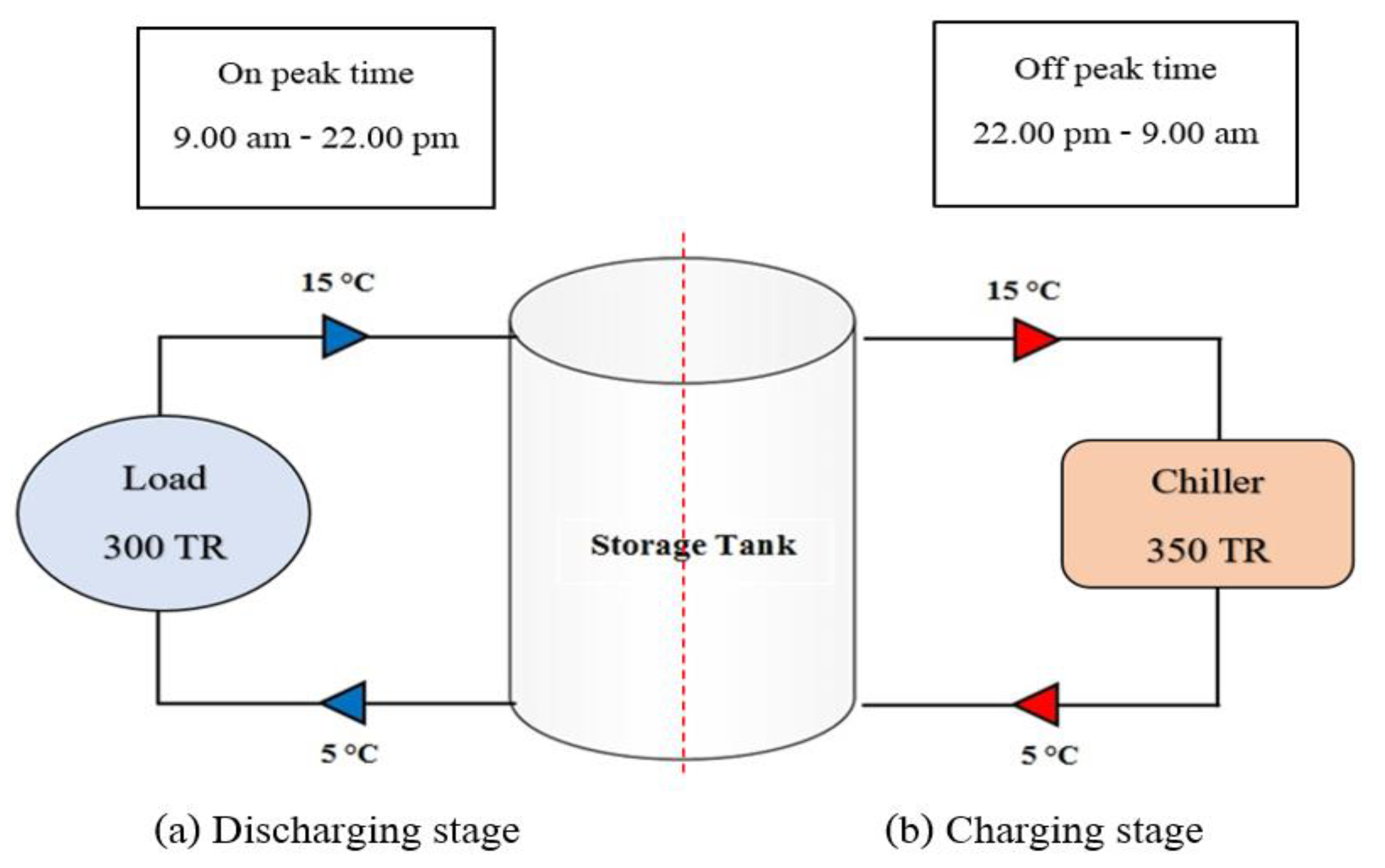
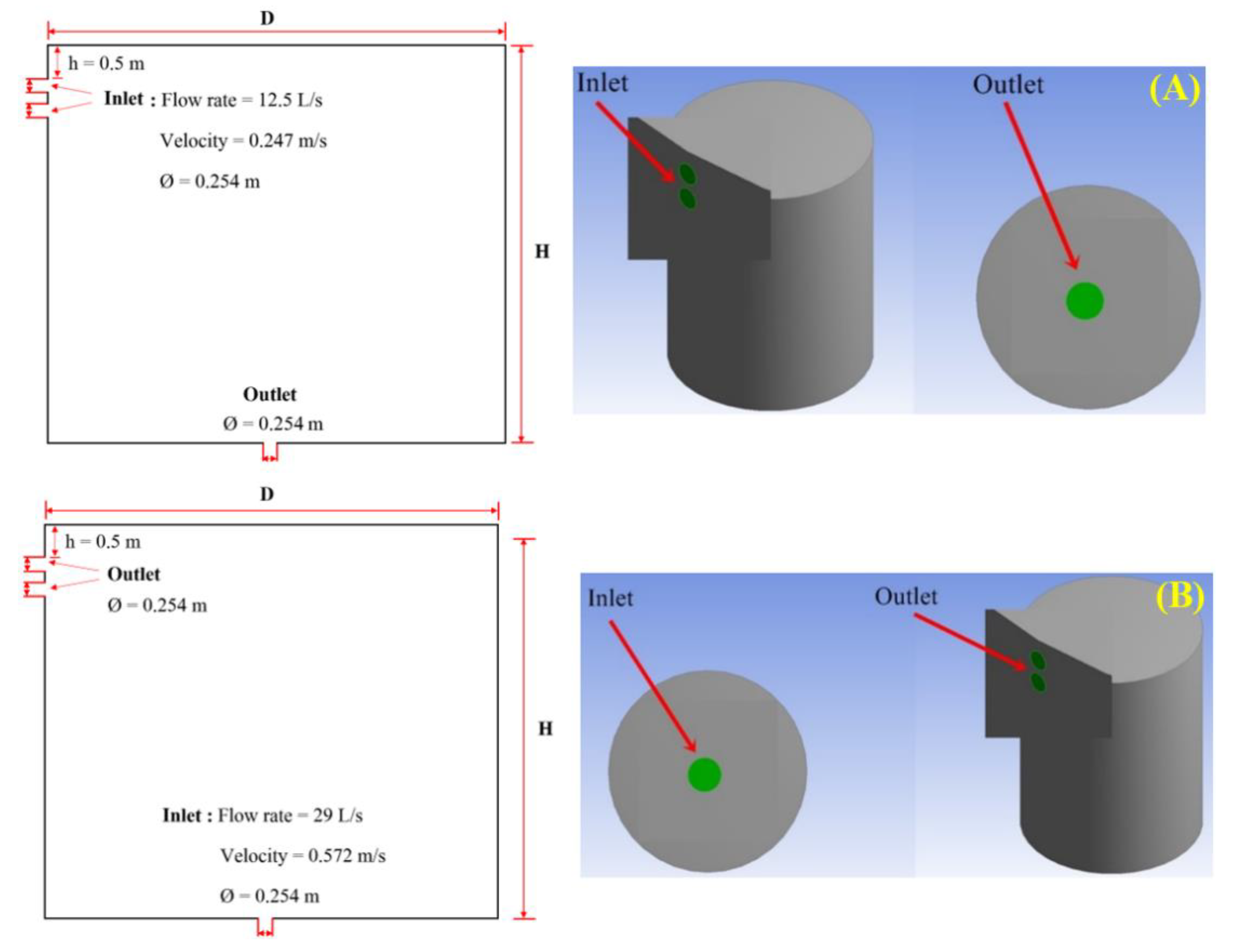

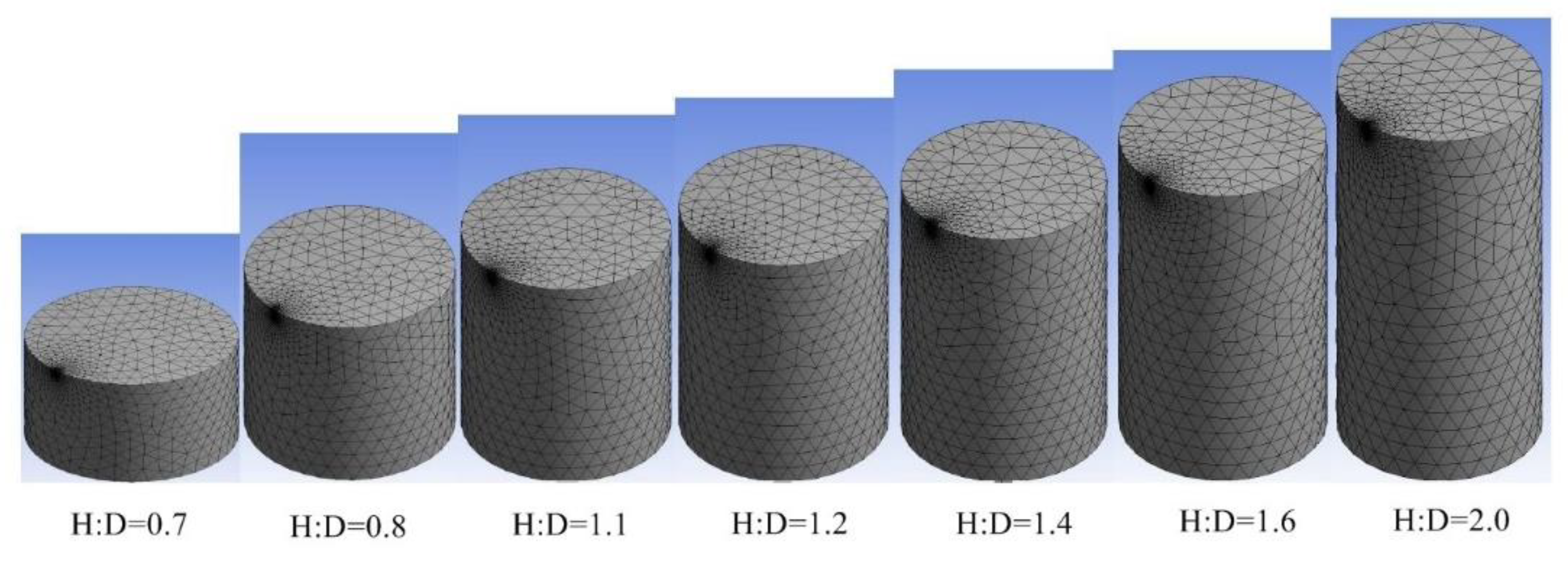

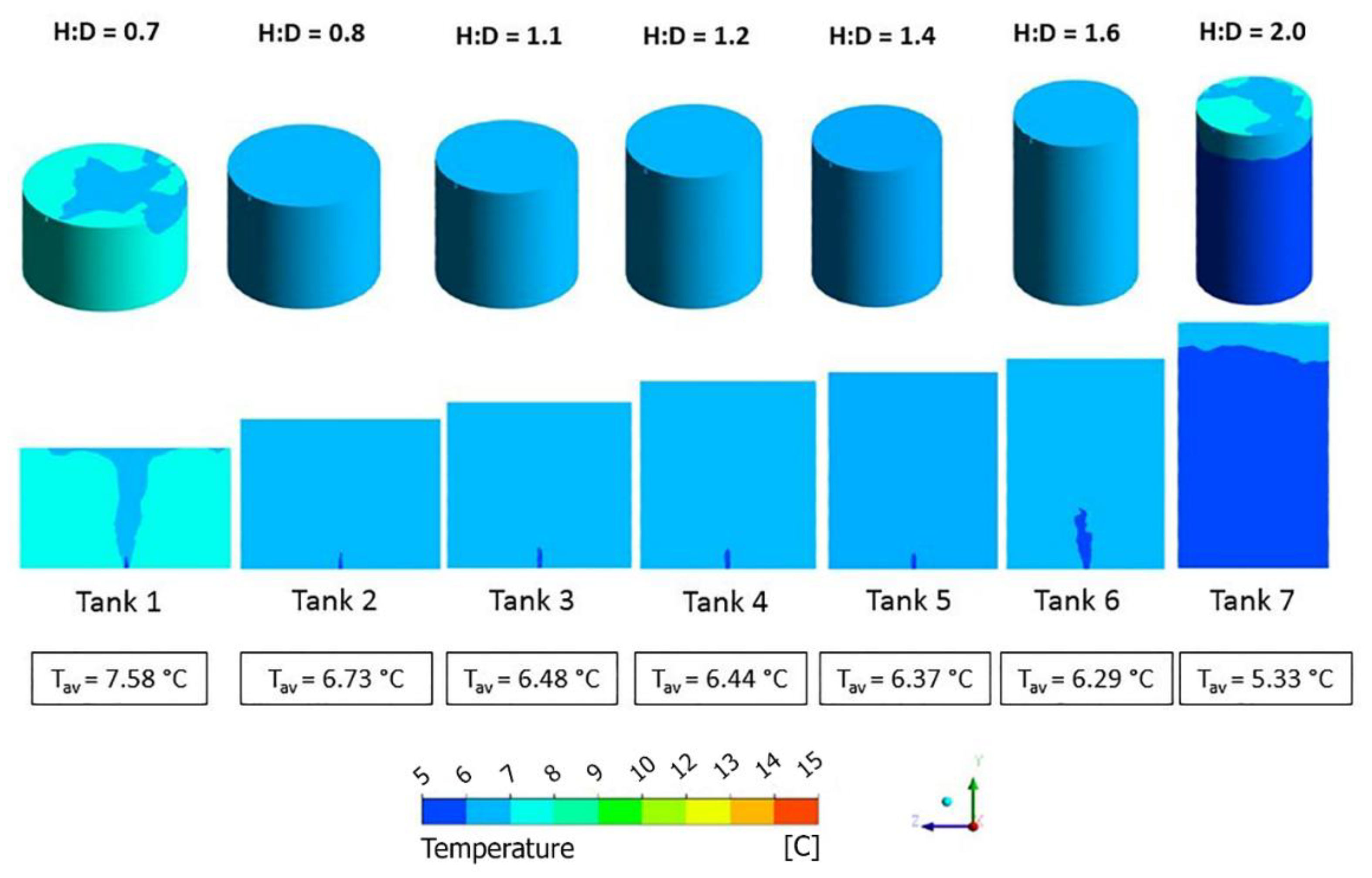
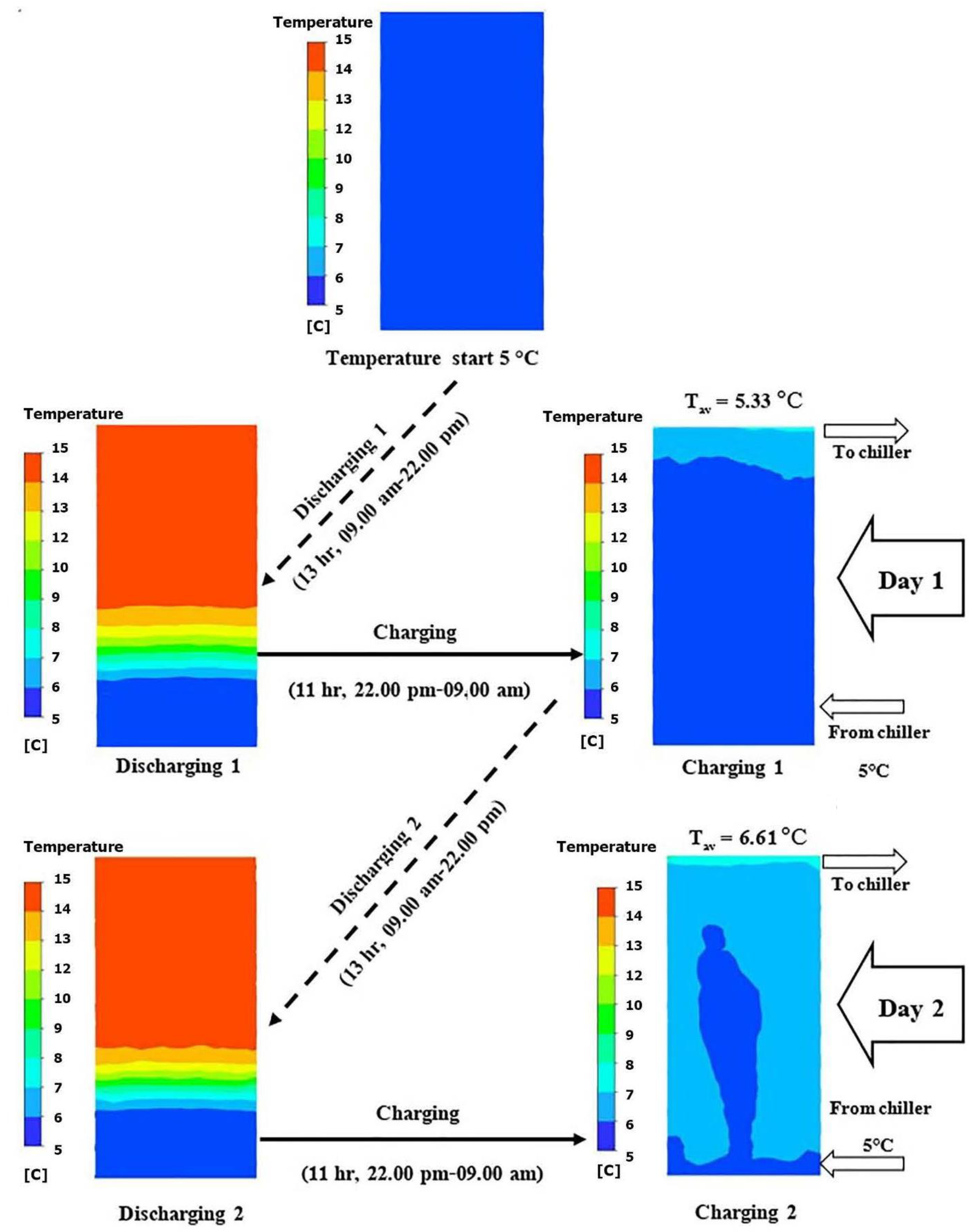
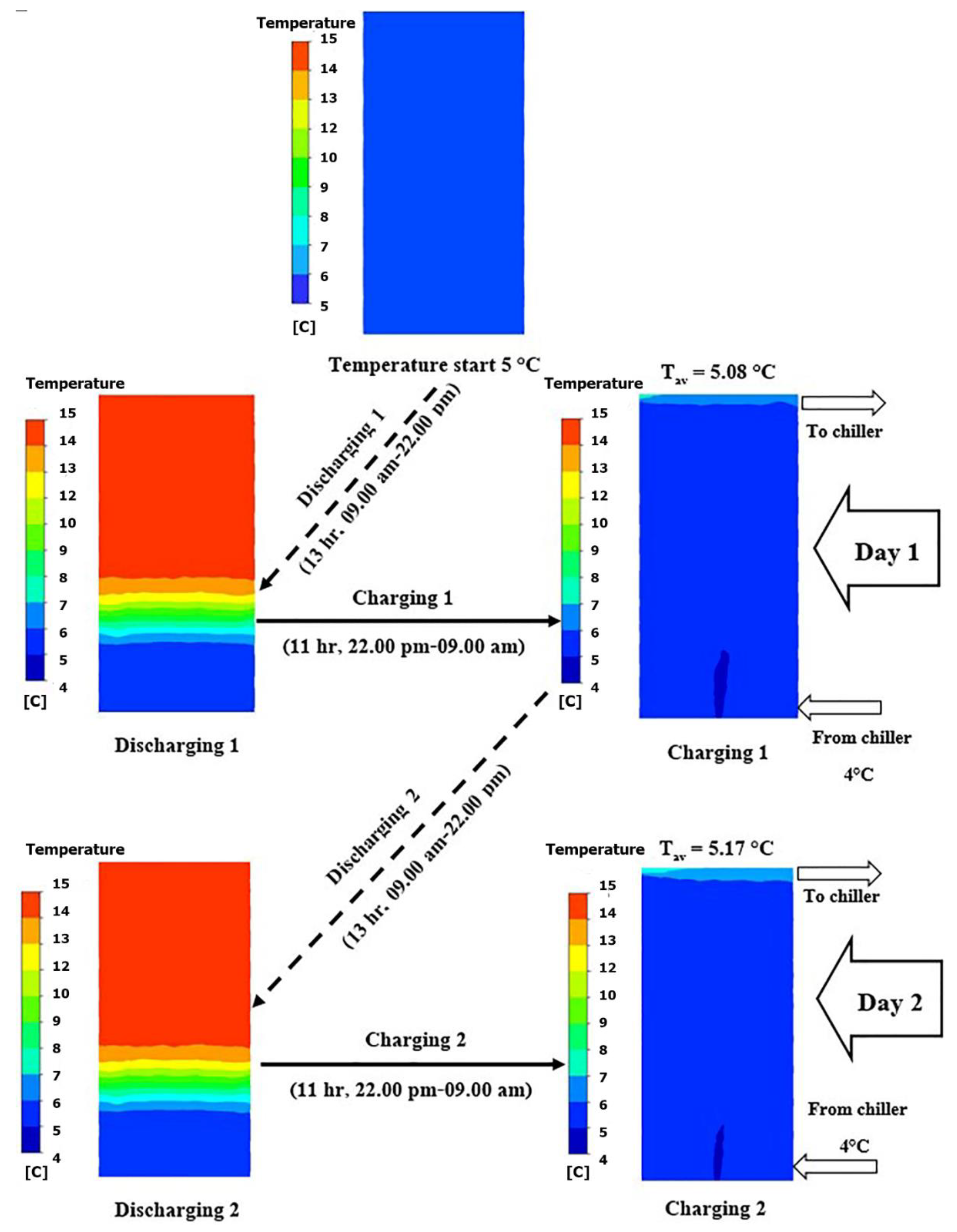

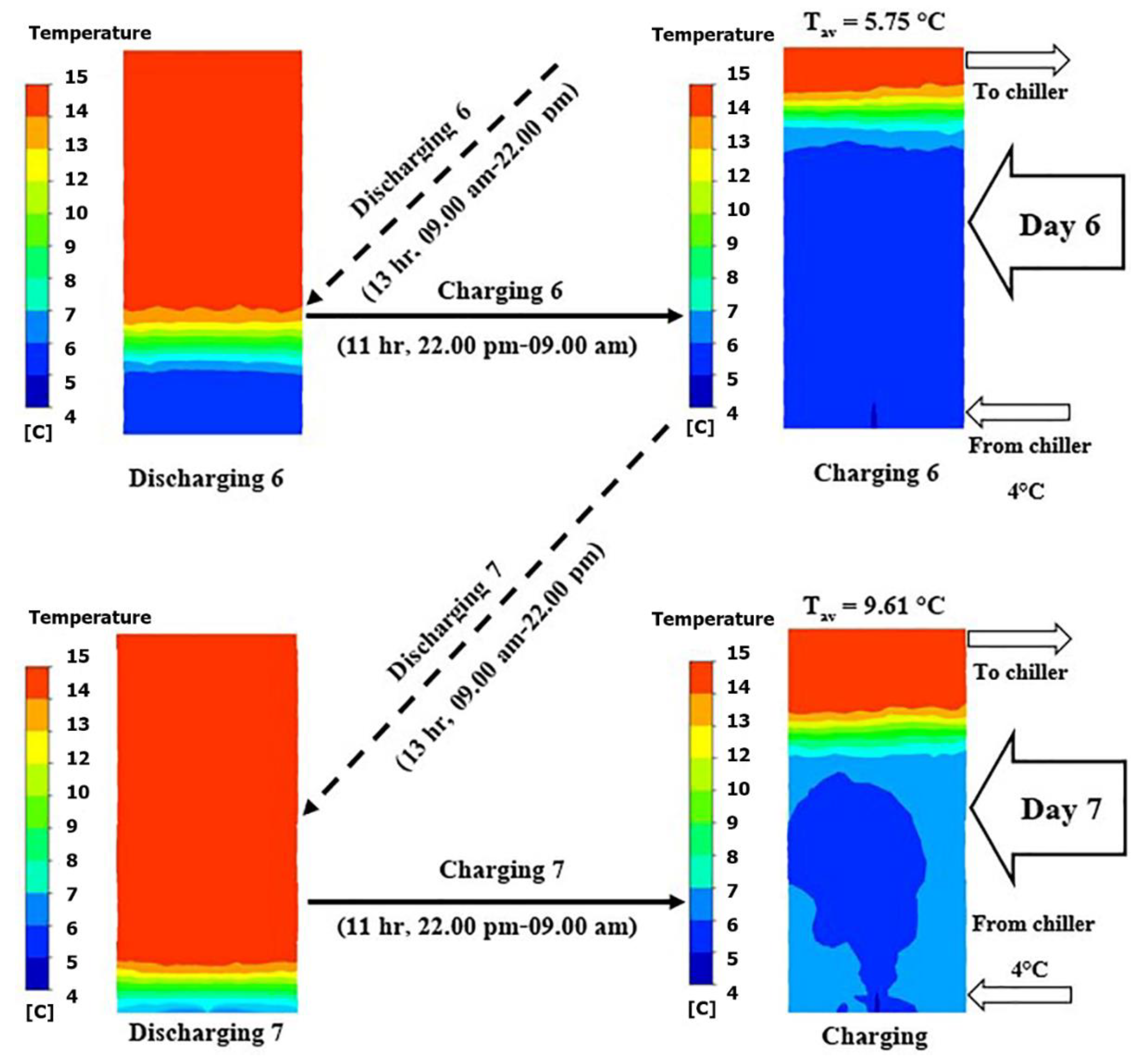
| Authors | Application Type | Study Environment | Location | Tank Size H × D (m)/H:D | Methods and Outcome |
|---|---|---|---|---|---|
| Sun et al. [60] | Cooling | Static and dynamic experiments | China | 1.2 × 1.6 |
|
| Sebzali et al. [61] | Cooling | Building energy simulation program | Kuwait | - |
|
| Majid and Soomro [62] | Cooling | Experiment | Malaysia | 15 × 22.3 |
|
| Shakerin et al. [63] | Cooling, heating and free cooling | MATLAB simulation | Norway | - |
|
| Shin et al. [64] | Cooling and heating | TRNSYS simulation | Republic of Korea | - |
|
| Bai et al. [65] | Heating and cooling | Simulation and experiment | China | 1:10, 1:5, 1:1, 5:1, 10:1 |
|
| Karim et al. [66] | Cooling | Simulation | Australia | - |
|
| Majid et al. [67] | Cooling | Simulation and experiment | Malaysia | 27.8 × 24.5 |
|
| Hasan and Theeb [68] | Cooling | Experiment | Iraq | 1.1 × 0.4 |
|
| Model | Height (m) | Diameter (m) | H:D Ratio |
|---|---|---|---|
| Tank 1 | 10.29 | 14.75 | 0.7 |
| Tank 2 | 12.00 | 13.64 | 0.8 |
| Tank 3 | 14.00 | 12.60 | 1.1 |
| Tank 4 | 15.20 | 12.10 | 1.2 |
| Tank 5 | 16.60 | 11.60 | 1.4 |
| Tank 6 | 18.38 | 11.00 | 1.6 |
| Tank 7 | 20.75 | 10.30 | 2.0 |
| Temperature Measurement | Discharging (°C) | Charging (°C) | ||||
|---|---|---|---|---|---|---|
| Simulation | Experiment | ΔT | Simulation | Experiment | ΔT | |
| T1 | 15 | 16.1 | 1.1 | 6.5 | 7.2 | 0.7 |
| T2 | 15 | 16.3 | 1.3 | 6.5 | 7.1 | 0.6 |
| T3 | 15 | 15.9 | 0.9 | 5 | 5.3 | 0.3 |
| T4 | 15 | 16.1 | 1.1 | 5 | 5.4 | 0.4 |
| T5 | 13.5 | 14.8 | 1.3 | 5 | 5.6 | 0.6 |
| T6 | 13.5 | 14.6 | 1.1 | 5 | 5.3 | 0.3 |
| T7 | 5 | 5.7 | 0.7 | 5 | 5.5 | 0.5 |
| T8 | 5 | 5.5 | 0.5 | 5 | 5.4 | 0.4 |
| Model | H:D | Volume of Cold Water (m3) | Cold Water (m3) | Cold Water (%) |
|---|---|---|---|---|
| Tank 1 | 0.7 | 1755 | - | - |
| Tank 2 | 0.8 | 1755 | 277.49 | 15.81 |
| Tank 3 | 1.1 | 1755 | 304.08 | 17.33 |
| Tank 4 | 1.2 | 1755 | 330.65 | 18.84 |
| Tank 5 | 1.4 | 1755 | 342.76 | 19.53 |
| Tank 6 | 1.6 | 1755 | 358.09 | 20.40 |
| Tank 7 | 2.0 | 1755 | 374.76 | 21.35 |
| Analysis | Results |
| electricity power of 350-TR chiller | 356.2 kW |
| TOU tariff (on-peak) TOU tariff (off-peak) | 0.14 USD/unit 0.08 USD/unit |
| Without TES system | |
| Period of operation per day | 13 h |
| electricity charge per day (TOU Rate) | 356.2 × 13 × 0.14 = 648.28 USD/Day |
| electricity charge per week (6 days operation) | 648.28 × 6 = 3889.70 USD/week |
| electricity charge per year year | 3889.70 × 52 = 202,264.61 USD/year |
| energy consumption per year | 356.2 × 13 × 6 × 52 = 1,444,747.2 kWh/year |
| With TES integrated system | |
| Period of operation per day (h) | 11 h |
| electricity charge per day (TOU Rate) | 356.2 × 11 × 0.08 = 313.46 USD/Day |
| electricity charge per week | 313.46 × 6 = 1880.76 USD/week |
| electricity charge per year | 1880.76 × 52 = 97,799.52 USD/year |
| energy consumption per year | 356.2 × 11 × 6 × 52 = 1,222,478.4 kWh/year |
| Savings | |
| electrical energy (kWh/year) saving | 222,268.8 kWh/year or 15.38% |
| electrical cost (US$/year) saving | 104,465.09 USD/year or 51.65% |
| Payback period | 5.55 years |
Publisher’s Note: MDPI stays neutral with regard to jurisdictional claims in published maps and institutional affiliations. |
© 2022 by the authors. Licensee MDPI, Basel, Switzerland. This article is an open access article distributed under the terms and conditions of the Creative Commons Attribution (CC BY) license (https://creativecommons.org/licenses/by/4.0/).
Share and Cite
Tipasri, W.; Suksri, A.; Velmurugan, K.; Wongwuttanasatian, T. Energy Management for an Air Conditioning System Using a Storage Device to Reduce the On-Peak Power Consumption. Energies 2022, 15, 8940. https://doi.org/10.3390/en15238940
Tipasri W, Suksri A, Velmurugan K, Wongwuttanasatian T. Energy Management for an Air Conditioning System Using a Storage Device to Reduce the On-Peak Power Consumption. Energies. 2022; 15(23):8940. https://doi.org/10.3390/en15238940
Chicago/Turabian StyleTipasri, Wunvisa, Amnart Suksri, Karthikeyan Velmurugan, and Tanakorn Wongwuttanasatian. 2022. "Energy Management for an Air Conditioning System Using a Storage Device to Reduce the On-Peak Power Consumption" Energies 15, no. 23: 8940. https://doi.org/10.3390/en15238940
APA StyleTipasri, W., Suksri, A., Velmurugan, K., & Wongwuttanasatian, T. (2022). Energy Management for an Air Conditioning System Using a Storage Device to Reduce the On-Peak Power Consumption. Energies, 15(23), 8940. https://doi.org/10.3390/en15238940








